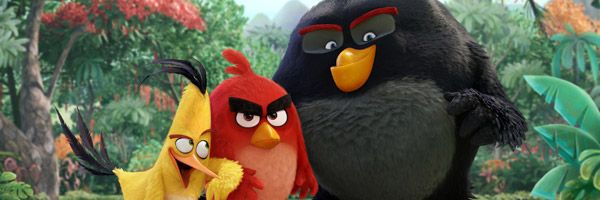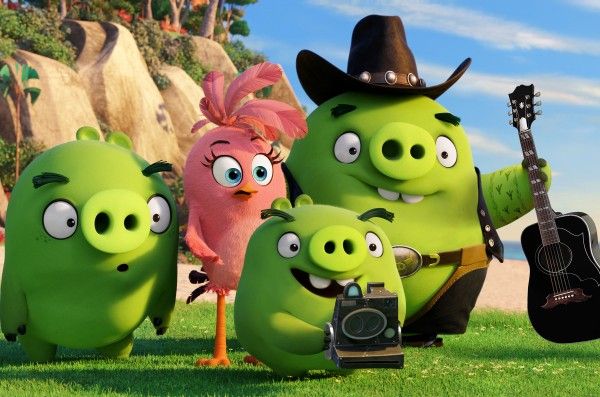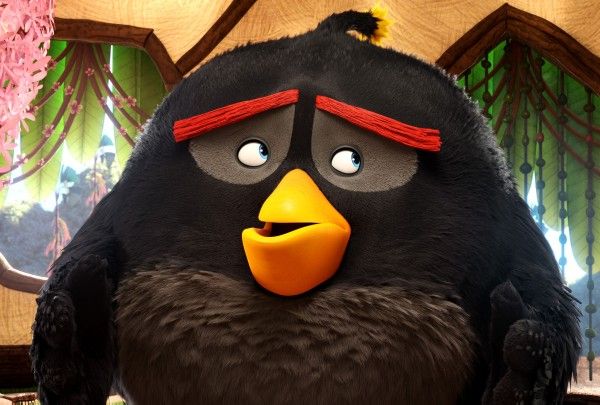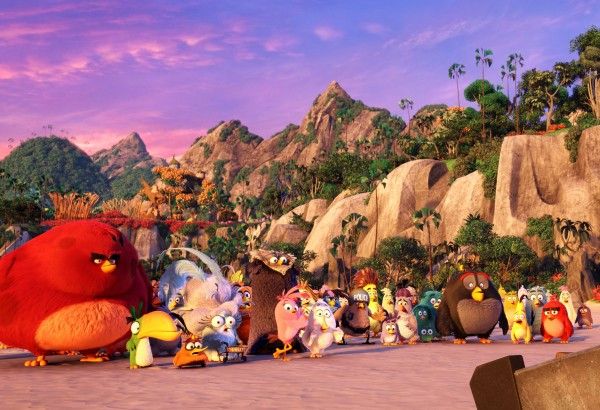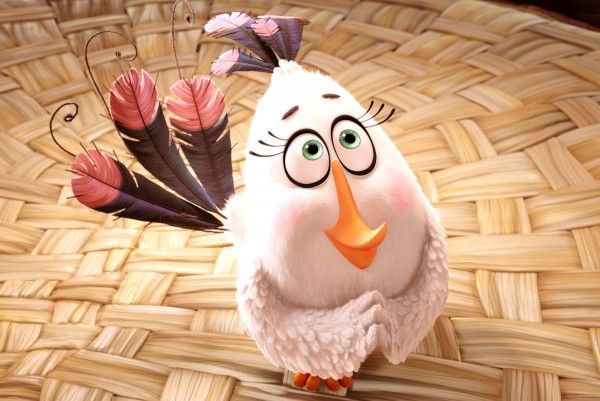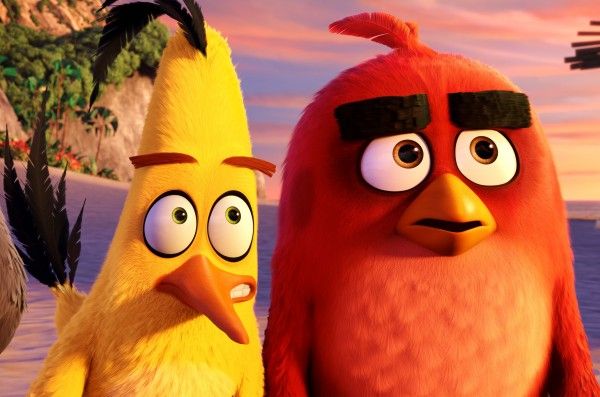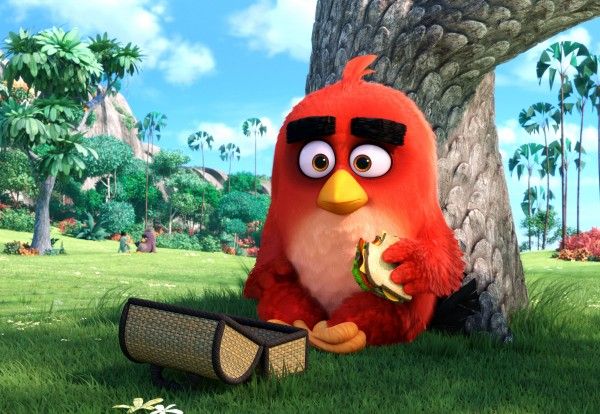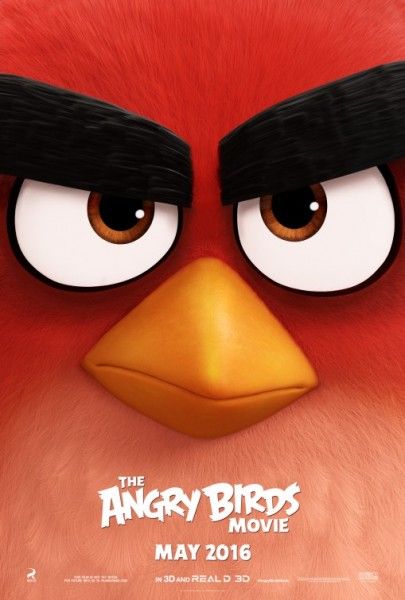Fergal Reilly and Clay Kaytis’ new 3D animated film, The Angry Birds Movie, is a delightful character-based comedy directed from a screenplay by Jon Vitti inspired by the wildly popular, most downloaded mobile game of all time. Working with Rovio Animation, the first-time helmers have created an exciting new story out of the basic premise of the game about what happens when little green piggies abscond with the eggs of some flightless fowl. The classic game serves as a great starting point for a lighthearted, entertaining movie featuring a superb voice ensemble that includes Peter Dinklage, Jason Sudeikis, Josh Gad, Danny McBride, and Maya Rudolph.
In an exclusive interview with Collider, the veteran animators talked about how the video-game crossover first emerged, how having studios in Sherman Oaks and Vancouver helped with a fast-paced production schedule, what appealed to them about Vitti’s script, why they set out to subtly subvert audience expectations, their most memorable moments working with an amazing voice cast, their collaboration with Brazilian composer Heitor Pereira on the film’s music, how they fleshed out the game characters for the big screen using the relationship between Red, Chuck and Bomb as the engine to drive the story, how they found the directing experience, and what they’re working on next. Check it all out in the interview below:
How did this project first come together for you?
CLAY KAYTIS: I had known John (Cohen), the producer of The Angry Birds Movie, from a small project I helped him out on years ago. I remember when I was reading the actual press release that he was producing this film, my phone rang, and it was John. He asked me if I would be interested in directing a movie. Then, a few weeks later, he got together with me and Fergal, who I’d never met before, and we got to know each other. We talked for three hours after that meeting about what we imagined a movie about Angry Birds could be. It was all speculation and imagination, but we were really excited about it because the story of the game held so much promise of a basic outline, but there was so much more that you could do with it. We were super excited to make a big broad comedy that had amazing action, which we really hadn’t seen in animated films before. So, that was just the start of me getting involved.
FERGAL REILLY: I was working at Sony. I was developing a project with Sam Raimi and Josh Donen called The Familiars. Then, John gave me a call out of the blue and said, “Do you want to come in and read the script?” I was like, “Sure,” wondering what I was going to read. I read it. I knew that Jon Vitti had written it. So, right away, I was tipped off that this was going to be smart humor. It’s going to be sophisticated in its sensibility, and sure enough, that’s the tone that I got off the page when we first read it. Then, I met Clay, and it was like…
KAYTIS: …long lost brothers.
REILLY: It was amazing creative chemistry right off the bat. I think that the producers spent a good deal of time casting for the directors and looking for the right kind of team of people who could do it. The reason they wanted a team was because we were going to make it in two cities and also other places around the world. Sony Pictures Imageworks, which did all the animation for us, were based in Vancouver. So, we had a studio in Sherman Oaks and a studio in Vancouver. That was great because we knew that we had a very fast production schedule as well, and the movie had to be done in two and a half years, which is quite a feat to be able to accomplish something of this kind of standard. That’s how it started.
When you first read Jon’s script, what appealed to you about the material?
KAYTIS: Jon Vitti has an amazing ability. You read a line of his dialogue and you know exactly how the joke is supposed to play, and the characters have such strong personalities and voices. That was what struck me the most. They already knew going in who these characters were. Having developed a lot of movies and worked on a lot of films, that’s a huge step forward at the beginning. Sometimes you have to discover who these characters are and why they’re together, but they had already worked that out which was great. So, that was a great starting point. We just knew, if we can base it on these guys, we can build a great story around them.
REILLY: Tonally, it caught me off guard. When I read the script, each of the characters, like Clay was saying, was unique and distinct, and comedically distinct, which is hard to do sometimes in a script. Some of the voices tend to blend together. But tonally, overall, the movie was smart and it had smart jokes, and it was definitely a level above what I was expecting. It had echoes of the tones of Arrested Development and The Simpsons. I was like, “Wow, people are not going to expect this.” They’re going to expect something that’s like bouncing balls and flying triangles. Immediately, from the beginning, the world had a level of sophistication to it which was relatable to our own, and putting in the personalities and situations where they get angry made it instantly relatable. That right there set a tonal base for me that made me realize this is going to be a different movie.
You have an amazing voice cast and there are so many great performances. What are some of the most memorable moments you had working with these actors?
REILLY: There are so many. We did a huge amount of recordings because we just kept getting better and better material. It was like we were spoiled for choice really. Every actor has a unique way of attacking the material. After every one of those sessions, you’d come out and your stomach muscles would be sore because you’d be laughing so hard.
KAYTIS: It was hard not to be starstruck honestly. There are so many great actors and comedians that we’ve all enjoyed and we got to work with them. It was really pretty special. Jason Sudeikis was amazing as Red. He really knew the film. He’d do one recording session and come back months later, and he would know all the jokes he said, all the things he referenced, and he would say, “Oh, I mentioned that last time, so I’ll just put that in this line and it’ll make the joke funnier. He was really onboard in terms of knowing exactly what he had done in the past. Then, you get people like Keegan-Michael Key who is an amazing improvisationer. To find the voice of the Judge, he would just rattle off these characters that came out of his mouth, and then we finally landed on the one that we all loved.
REILLY: It’s always like that. The first recording sessions are always quite experimental, because you’re looking for the right voice for the character. We like to spend the first couple sessions just finding the voice, because the actors are also searching as well. They’re searching for a place where they can go back to it again and again and again. That was really fun. The first time meeting Peter Dinklage and the first recording session with him, he came in and he sat down for 40 minutes. He was an absolute sweetheart. We talked about how he’d shot Game of Thrones in Northern Ireland. I’m from Ireland originally, so I know that whole area. I know Belfast very well. We were talking about where he went with his family up to Donegal. That was a great way to begin, because you feel like you’re connected a little bit. For him, he’s such a huge personality on screen that it helps you sink into the record and get over your nerves. Each of them has that. Maya was wonderful. She’s just so warm. The Matilda part was actually small. We kept having to make it bigger and bigger because Maya was so good. We were getting this great material from every session with her, so we kept trying to make it bigger and bigger. She needs her own movie. So, it was really fun that way.
Can you talk about the film’s music and your collaboration with composer Heitor Pereira?
KAYTIS: Heitor was amazing. He’s this magic Brazilian man. He’s like a little Brazilian elf. He’s just so excited.
REILLY: He’s a Brazilian musical witch doctor.
KAYTIS: He’s amazing. He comes with so much energy and experience, and I think his Brazilian background brings this rhythmic sense to everything he does. He’ll sit there and he’ll beatbox a rhythm of a song and he’ll play it with his mouth. It turns out that a lot of the percussion in the movie is him actually making those noises into a microphone, filtering those in to sound like instruments. He does this really creative, collaborative thing. His studio is filled with these weird, strange, broken instruments that he plays because they sound broken. It was an amazing experience. It’s not a traditional kind of score.
REILLY: Heitor has his own style, like Clay was saying, because he comes from pop music. His primary instrument is the guitar. Everything is filtered through that process and he is very attuned to rhythm and sound. Very early on, he really wanted to create in the body of the music – and he’s from Brazil and so he’s like, “I have all these bird sounds that I recorded and I want to incorporate them into the soundtrack. This is part of the musical landscape of Bird Island.” He immediately had a fresh approach to the music. He’s just a master at creating beautiful melody in his music. He can do the sweeping stuff beautifully, but the melodies in his music are amazing. He came to us after one session where he was saying, “I think this could be something for Red’s theme, and I think this could be something for Bill Hader’s character, Leonard’s theme, and the Pigs’ theme.” These two things were just so different, but he had a Russian march idea in the first Pig themes. Then, he had this great warmth to Red’s theme. His melodies are spectacular. He creates such appealing melodies in his music.
KAYTIS: We asked him not to be beholding to the original game. We like it, and there are hints of it in the score, but we said, “You don’t have to orchestrate that. You can make whatever music you want.” But, he did really honor it, because the music would go “Da-da-da-da-da” and he’s taken that little refrain and repeated it as a rhythm underneath other music that he’s playing. He’s always honoring the original source but doing his own thing. I loved his score. I think it’s fantastic.
REILLY: The score is amazing.
How challenging was it to flesh out game characters and bring them to life on the big screen when you have a built-in audience that loves the game and has a history with it?
REILLY: We didn’t think about the intimidation factor. There was a lot of noise about how do you turn an app into a video game. But, for us, as soon as we see the creative problem, we just start to focus on it. Both our trainings, I mean, we’ve spent our whole careers creating character. It’s an intense process, but that’s what we’ve done.
KAYTIS: We can’t help it.
REILLY: All the movies that Clay has worked on – Tangled comes to mind and Frozen – and the movies that I’ve worked on, it’s all about character. It’s all about finding the core of the character. We knew that if we could do that for Red, Chuck and Bomb, then that was the key to unlocking the story. It was almost like character drove story and not the other way around.
KAYTIS: Fortunately, with the game, there’s not a deep backstory. These basic icons represent these different skills for these birds, but that’s it. That gave us a lot of freedom to make the characters what we wanted them and needed them to be for the story. It was freeing to know that that’s the groundwork, but then we can take that. I always look at it like the game is one view of that world, and then they did these Angry Bird Toons that were hand-drawn animation. That’s like another lens on that. It’s another level of detail. Then, they did these Piggy Tales, which were these 3-D Claymation-looking things. And now, we get to have this fourth lens where we actually make this fully fledged world in 3D where you can see the details of their feathers and the trees and everything. This was like the ultimate kind of expression of that simplified game world.
REILLY: With fully realized characters, too. You’re always working on each character as individuals, but then you’re trying to make connections between them. You’re trying to create comedic electricity. It’s amazing when you think about it. In live action, you have actors on a set that are reacting off each other. In animation, we’re creating all those connections artificially. So, the relationship between Red, Chuck and Bomb, that’s an artificial construct. We have those individual characters like little connections on a board and we’re trying to create sparks of comedic electricity between them. We found out early on, in a couple of scenes, that every time these three guys are together, the audience wanted more. We used those, the relationship between Red, Chuck and Bomb, like the engine to drive the story.
How did you find the directing experience? Would you like to direct more?
KAYTIS: It’s funny, you never know until you try it, but I loved it. I loved directing. It was taking all the things I’ve learned over my whole career and focusing them and taking the responsibility of, “Okay, don’t mess this up!” It’s a lot of pressure, but it’s also a lot of fun to put your voice and your expression into a film. I relate to this film so much in terms of the comedy, the characters, the humor, and the animation style. It was really a special experience.
REILLY: As a director, I think your primary goal is to give the audience a special experience, and you’re constantly aware of the responsibility of that. I want to create something that’s really entertaining and funny, but I want other people to share in this and have this great, entertaining experience. That’s what drives me to want to tell these stories. It was a great experience and unique in a way because we were doing something that wasn’t an original concept. It was coming from a game. That presented its own challenge. Then, at the same time, you would think there would be a lot of restrictions on that, especially for two first-time directors, but they let us blue sky the entire world and the characters in it. We couldn’t have asked for a better experience.
What are you working on next that you’re excited for people to know about?
KAYTIS: Well, the movie comes out in two and a half weeks, so a big part of what we’re doing right now is just waiting for it to come out and seeing the reaction from people. My family hasn’t seen it yet, so I’m really excited for them to check it out. We’re really proud of this film. And then, it’s just figuring out what we’re going to do next. I’m not quite sure yet.
REILLY: There are a lot of little projects that I’m excited about. I’ve been reading a lot of scripts – live action, animation, hybrid ideas. We’re talking to lots of different people about projects. It’s an exciting time. But definitely, me personally, I see the mediums of film, technology, and games coming together, and I love combining those three, and I’m excited by those three elements together. So, projects that have those elements are always fun.
The Angry Birds Movie opens in theaters on May 20th.

